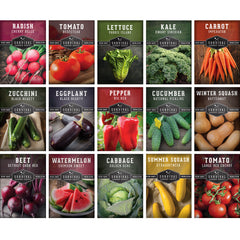It’s that time in late Summer when the heirloom tomatoes are in abundance and you have more than you can eat immediately. This is a good time to preserve that Summer flavor to sustain you through the winter months.
There are so many different ways to prepare and preserve tomatoes, but this post is going to deal with 3 basic ways to keep your tomatoes, freezing, drying, and canning. Even these three simple methods have multiple variations that depend on the type of tomato and your plans for the preserved tomatoes.
Freezing

Freezing is by far the most simple method to store your tomatoes for future use, however, you want to keep in mind how you plan to use them. Meaty beefsteak-type tomatoes will break down after being frozen so they will be good to use in sauces and stews. Paste-type tomatoes like Roma tomatoes generally hold their shape and can be used almost as if they were fresh.
Freezing Whole
The quickest and easiest way to freeze a tomato is to simply wash and destem the tomato and let it dry. Place the tomatoes on a baking sheet so they do not touch each other and then place the sheet into the freezer. Once the tomatoes are frozen solid, you can pack them into a ziplock freezer bag, removing as much air as possible. You could also bag them and seal them with a vacuum sealer if available. This will allow you to use the tomatoes one at a time. They should last at least a full year this way.
Blanching and Skinning
You may want to do some further preparation before freezing and remove the core and skins from the tomatoes. To prep the tomatoes, use a sharp knife to cut the core from the top of the tomato and make a slit down the side of the tomato. Drop the tomatoes into a pot of boiling water for 60 to 90 seconds. With a slotted spoon, remove the tomatoes from the boiling water and drop them immediately into an ice water bath. Using the slotted spoon again, remove the tomatoes and pull the skin right off. The skinned tomatoes can then be put into freezer bags and frozen.
Drying

Drying tomatoes concentrates the flavor and allows you to store more tomatoes in less space. There are several ways to dry tomatoes depending on your climate and patience. You can dry any size or type of tomato; however, it is best to dry similar size tomatoes in the same batch.
Sun Drying
People have been letting Mother Nature dry their tomatoes for centuries. To be successful, you need a consistently warm and dry environment. Simply wash and slice your tomatoes in half and lay skin side down on a screen (raised for airflow underneath) out in the sun. Sprinkle with a little sea salt, if you like. You can cover the tomatoes with a cheesecloth to keep pests away and they should be brought inside at night. Drying can take several days to two weeks.
Oven Drying
If waiting for nature to do the work is not an option, you can dry your tomatoes in an oven. Preheat your oven to 250 degrees Fahrenheit and put your halved tomatoes skin side down on a parchment paper-lined baking sheet. Bake for 2 1/2 to 3 1/2 hours.
Dehydration
Dehydration is another easy method to dry your tomatoes. You should set the temperature on your dehydrator to about 140 degrees Fahrenheit. It should take 10 to 18 hours to properly dry your tomatoes.
Storage
You’ll know your tomatoes are ready when they are very dry but still pliable. Your dried tomatoes can be stored in the fridge in an airtight container for several months. You can also pack your tomatoes in olive oil for long periods.
To pack your tomatoes in oil, rehydrate them for about 30 minutes in warm water and pat dry. To prevent bacterial growth, dip the tomatoes in wine vinegar, lemon, or lime juice before adding them to the storage jar. You can layer tomatoes with dried herbs and garlic for additional flavor - the tomatoes will keep in well-sealed jars for several months. If you use fresh herbs, store the jars in the refrigerator and use them within a few days.
Canning

The final method we will discuss to preserve tomatoes is canning. Because tomatoes are high in acid, they should be processed like other fruit in a boiling-water canner with the addition of added citrus or vinegar to inhibit bacterial growth.
Supplies
You will need glass canning jars, lids, screw-on rings, bottled lemon juice, and a large pot for boiling water. For each pint of canned tomatoes, you will want to start with 1 1/4 - 1 1/2 pounds of whole tomatoes. If using quart jars, you’ll want to start with about 3 pounds of fresh tomatoes per quart.
Preparation
While preparing your tomatoes, it is vital to sterilize your canning jars. Place clean jars on a rack inside a large pot of hot water, making sure the jars are covered with water. Bring the pot to a simmer over medium heat and let the jars simmer for 10 minutes. Keep the jars hot in the water until you are ready to use them. While the jars are simmering, in a separate bowl, pour some water from the jar pot over the lids. Don’t boil the lids. The screw bands don’t have to be sterilized but should be clean.
To prepare the tomatoes, blanch and peel the tomatoes as described above in the section on freezing. If desired, cut the tomatoes in half or dice them.
Filling the Jars
Use a wide-mouth funnel to fill the jars, one at a time, with tomatoes and any juices from prepping. Add 1 tablespoon of lemon juice per pint (or 2 tablespoons if using quart jars) and boiling water until you have ½ an inch of headspace. You do not want liquid touching the jar lid.
Remove the funnel and wipe the jar rim with a clean, damp cloth to remove any food residue so that the lids will properly seal.
The Canning Process
Position the prepared lids and screw rings onto the jars and tighten them according to the jar manufacturer’s directions. Place the jars into the canning pot, making sure they do not touch one another. Cover the canner and process the jars once the water is boiling for 40 minutes for pints or 45 minutes for quarts.
Remove the jars from the canner and allow them to cool. When the jars are completely cool, press the center of the lid to check the seal. If the lid stays dipped in when you press, the seal is good and you can fully tighten the screw ring, label, and store your tomatoes. Unsealed jars can be stored in the refrigerator and used within a few days or you can reprocess the jars within 24 hours. Properly sealed tomatoes should keep their optimum flavor for up to a year.
About The Tomatoes
Survival Garden Seeds offers a wide variety of heirloom tomatoes selected specifically for their ease of growing, high yields, and suitability as survival food. Our tomatoes make great tomato sauce or salsa and will be flavorful and delicious whether preserved or fresh.
For more information on safely canning tomatoes and other food storage practices, we recommend the National Center for Home Food Preservation. You can also download free Canning Tips from the US FDA website catalog.























